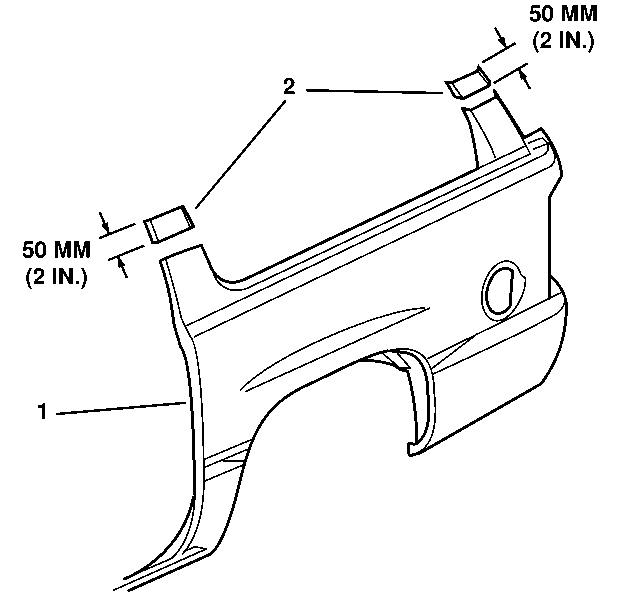Removal Procedure
The quarter panel can be serviced as a complete panel or sectioned.
When complete panel replacement is performed, the roof panel must be removed
and replaced. For sectioning, the quarter panel can be replaced by making
sectioning cuts at the window pillars.

- Remove all related panels
and components.
- Restore as much of the damage as possible to factory specifications.
- Note the location and remove the following as necessary:
| • | Anti-corrosion materials |
Important: Do not damage the inner panels or reinforcements.
- Cut the quarter panel in the location where sectioning is to be performed.
- Locate and drill out all factory welds. Note the number and location
of the welds for installation of the service part.
- Remove the damaged quarter panel section.
Installation Procedure

- Cut the replacement quarter
panel in corresponding locations to fit the remaining original panel. The
sectioning joint should be trimmed to allow a gap of1 ½
times the metal thickness at the sectioning joint.
- Create a 50 mm (2 in) backing plate from the unused
portion of the service part. Trim the backing plate as necessary to fit behind
the sectioning joint.
- Drill 8 mm (5/16 in) plug weld holes along the
sectioning cut on the remaining original panel. Locate these holes 13 mm
(1/2 in) from the edge and spaced 40 mm (1-½ in)
apart.
Important: In any area damaged beyond recognition, space plug weld holes every
40 mm (1-½ in) apart.
- Drill 8 mm 5/16 in) plug weld holes in the service panel
as necessary in the locations noted from the original panel and along the
sectioning cut.
Notice: Use the correct fastener in the correct location. Replacement fasteners
must be the correct part number for that application. Fasteners requiring
replacement or fasteners requiring the use of thread locking compound or sealant
are identified in the service procedure. Do not use paints, lubricants, or
corrosion inhibitors on fasteners or fastener joint surfaces unless specified.
These coatings affect fastener torque and joint clamping force and may damage
the fastener. Use the correct tightening sequence and specifications when
installing fasteners in order to avoid damage to parts and systems.
- Prepare all attachment
surfaces as necessary.
- Apply weld-thru primer to all bare metal surfaces.
- Fit the backing plate halfway into the sectioning joint, clamp
and plug weld to the vehicle.
- Align the quarter panel to adjacent panels using 3-dimensional
measuring equipment. Leave a gap of 1 ½ times the
metal thickness at the sectioning joint.
- Plug weld accordingly.
- To create a solid joint with minimal heat distortion to make 25 mm
(1 in) stitch welds along the seam with 25 mm (1 in)
gaps between them, then go back and complete the stitch weld.
- Clean and prepare all welded surfaces.
Important: Prior to refinishing, refer to publication GM 4901M-D-2000 GM
Approved Refinish Materials for recommended products. Do not combine paint
systems. Refer to paint manufacturer's recommendations.
- Apply the following as necessary:
| • | Anti-corrosion materials |
- Install all related panels and components.


